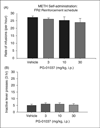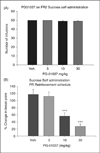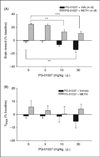PG01037, a novel dopamine D3 receptor antagonist, inhibits the effects of methamphetamine in rats
- PMID: 20142301
- PMCID: PMC3729962
- DOI: 10.1177/0269881109358201
PG01037, a novel dopamine D3 receptor antagonist, inhibits the effects of methamphetamine in rats
Abstract
Our previous studies have shown that the selective dopamine D(3) receptor antagonists SB-277011A or NGB 2904 significantly attenuate cocaine self-administration under a progressive-ratio reinforcement schedule and cocaine-, methamphetamine- or nicotine-enhanced brain stimulation reward. However, the poor bioavailability of SB-277011A has limited its potential use in humans. In the present study, we investigated the effects of the novel D(3) receptor antagonist PG01037 on methamphetamine self-administration, methamphetamine-associated cue-induced reinstatement of drug seeking and methamphetamine-enhanced brain stimulation reward. Rats were allowed to intravenously self-administer methamphetamine under fixed-ratio 2 and progressive-ratio reinforcement conditions, and then the effects of PG01037 on methamphetamine self-administration and cue-induced reinstatement were assessed. Additional groups of rats were trained for intracranial electrical brain stimulation reward and the effects of PG01037 and methamphetamine on brain stimulation reward were assessed. Acute intraperitoneal administration of PG01037 (3, 10, 30 mg/kg) failed to alter methamphetamine or sucrose self-administration under fixed-ratio 2 reinforcement, but significantly lowered the break-point levels for methamphetamine or sucrose self-administration under progressive-ratio reinforcement. In addition, PG01037 significantly inhibited methamphetamine-associated cue-triggered reinstatement of drug-seeking behavior and methamphetamine-enhanced brain stimulation reward. These data suggest that the novel D(3) antagonist PG01037 significantly attenuates the rewarding effects as assessed by progressive-ratio self-administration and brain stimulation reward, and inhibits methamphetamine-associated cue-induced reinstatement of drug-seeking behavior These findings support the potential use of PG01037 or other selective D(3) antagonists in the treatment of methamphetamine addiction.
Figures






Similar articles
-
The novel dopamine D3 receptor antagonist NGB 2904 inhibits cocaine's rewarding effects and cocaine-induced reinstatement of drug-seeking behavior in rats.Neuropsychopharmacology. 2006 Jul;31(7):1393-405. doi: 10.1038/sj.npp.1300912. Epub 2005 Oct 5. Neuropsychopharmacology. 2006. PMID: 16205781
-
Dopamine D(3) receptor antagonist SB-277011A inhibits methamphetamine self-administration and methamphetamine-induced reinstatement of drug-seeking in rats.Eur J Pharmacol. 2011 Jun 1;659(2-3):187-92. doi: 10.1016/j.ejphar.2011.02.046. Epub 2011 Apr 3. Eur J Pharmacol. 2011. PMID: 21466803 Free PMC article.
-
The preferential dopamine D3 receptor antagonist S33138 inhibits cocaine reward and cocaine-triggered relapse to drug-seeking behavior in rats.Neuropharmacology. 2009 Mar;56(4):752-60. doi: 10.1016/j.neuropharm.2008.12.007. Neuropharmacology. 2009. PMID: 19136017 Free PMC article.
-
Pharmacological actions of NGB 2904, a selective dopamine D3 receptor antagonist, in animal models of drug addiction.CNS Drug Rev. 2007 Summer;13(2):240-59. doi: 10.1111/j.1527-3458.2007.00013.x. CNS Drug Rev. 2007. PMID: 17627675 Free PMC article. Review.
-
Current perspectives on selective dopamine D(3) receptor antagonists as pharmacotherapeutics for addictions and related disorders.Ann N Y Acad Sci. 2010 Feb;1187:4-34. doi: 10.1111/j.1749-6632.2009.05149.x. Ann N Y Acad Sci. 2010. PMID: 20201845 Free PMC article. Review.
Cited by
-
Dopamine D3 Receptor Availability Is Associated with Inflexible Decision Making.J Neurosci. 2016 Jun 22;36(25):6732-41. doi: 10.1523/JNEUROSCI.3253-15.2016. J Neurosci. 2016. PMID: 27335404 Free PMC article.
-
Opposing effects of dopamine D1- and D2-like agonists on intracranial self-stimulation in male rats.Exp Clin Psychopharmacol. 2016 Jun;24(3):193-205. doi: 10.1037/pha0000067. Epub 2016 Mar 17. Exp Clin Psychopharmacol. 2016. PMID: 26987070 Free PMC article.
-
Characterization of the transport, metabolism, and pharmacokinetics of the dopamine D3 receptor-selective fluorenyl- and 2-pyridylphenyl amides developed for treatment of psychostimulant abuse.J Pharmacol Exp Ther. 2010 Jun;333(3):854-64. doi: 10.1124/jpet.109.165084. Epub 2010 Mar 12. J Pharmacol Exp Ther. 2010. PMID: 20228156 Free PMC article.
-
Nucleus accumbens hyperpolarization-activated cyclic nucleotide-gated channels modulate methamphetamine self-administration in rats.Psychopharmacology (Berl). 2016 Aug;233(15-16):3017-29. doi: 10.1007/s00213-016-4349-z. Epub 2016 Jun 22. Psychopharmacology (Berl). 2016. PMID: 27329413
-
Effects of Environmental Manipulations and Treatment with Bupropion and Risperidone on Choice between Methamphetamine and Food in Rhesus Monkeys.Neuropsychopharmacology. 2015 Aug;40(9):2198-206. doi: 10.1038/npp.2015.63. Epub 2015 Mar 6. Neuropsychopharmacology. 2015. PMID: 25742872 Free PMC article.
References
-
- Arnold JM, Roberts DC. A critique of fixed and progressive ratio schedules used to examine the neural substrates of drug reinforcement. Pharmacol Biochem Behav. 1997;57:441–457. - PubMed
-
- Ashby CR, Paul M, Gardner EL, Heidbreder CA, Hagan JJ. Acute administration of the selective D3 receptors antagonist SB-277011-A blocks the acquisition and expression of the conditioned place preference response to heroin in male rats. Synapse. 2003;48:154–156. - PubMed
-
- Austin NE, Baldwin SJ, Cutler L, et al. Pharmacokinetics of the novel, high-affinity and selective dopamine D3 receptor antagonist SB-277011A in rat, dog and monkey: in vitro/in vivo correlation and the role of aldehyde oxidase. Xenobiotica. 2001;6:677–686. - PubMed
-
- Bauco P, Wise RA. Synergistic effects of cocaine with lateral hypothalamic brain stimulation reward: lack of tolerance or sensitization. J Pharmacol Exp Ther. 1997;283:1160–1167. - PubMed
-
- Bossert JM, Ghitza UE, Lu L, Epstein DH, Shaham Y. Neurobiology of relapse to heroin and cocaine seeking: an update and clinical implications. Eur J Pharmacol. 2005;526:36–50. - PubMed
Publication types
MeSH terms
Substances
Grants and funding
LinkOut - more resources
Full Text Sources
Medical

